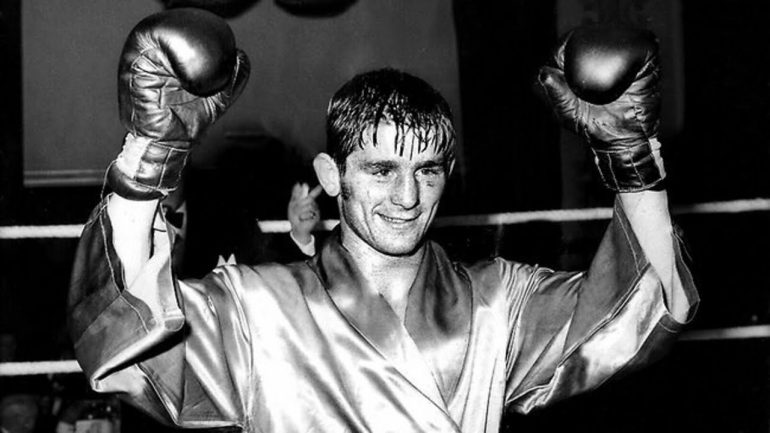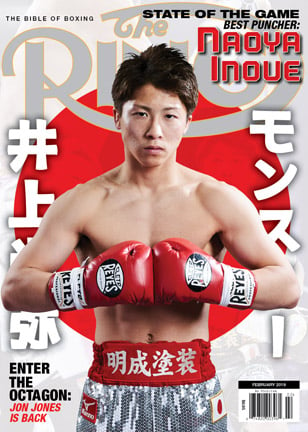Best I Faced: Johnny Famechon

Johnny Famechon was a highly skilled featherweight who enjoyed a successful 10-year career that culminated in a world title win 50 years ago today.
Jean-Pierre Famechon was born in Paris, France, in March 1945. He came from a boxing family; his father and four uncles winning French national titles. Out of the brothers, Ray was the most successful winning the European championship and unsuccessfully challenged Willie Pep for the featherweight world title in March 1950.
Two of the Famechon brothers were offered deals to emigrate and fight out of Australia when Johnny was young.
“My father, Andre, came out to Australia in December 1948,” Famechon told The Ring. “Stadiums Limited brought him and his brother, Ray, out to Australia for fights.
“Mum, my younger brother, Christian, and I came out to Australia in 1950, once dad was settled.”
In 1961 a 16-year-old Famechon – with no amateur experience – followed in his father’s and uncle’s footsteps when he made his professional debut. The young novice started out with a draw but by 1964 he’d won the Australian featherweight title.
Famechon remained active and added the Commonwealth championship with an 11th-round stoppage over John O’Brien at Festival Hall in Melbourne, his home away from home, in November 1967.
On Jan. 21, 1969 Famechon traveled to London and met the talented Jose Legra for the WBC featherweight title. Famechon edged the Spanish-based Cuban to win the world title by hard-fought 15-round decision at the famous Albert Hall.
“I was elated,” he said of winning the world title. “All the work that [my trainer] Ambrose [Palmer] and I put in boxing had paid off.”
In the summer of 1969, Famechon met former two-weight world champion Fighting Harada and both men were on the canvas during an exciting contest. Ironically, the lone judge was Willie Pep, who was now functioning as a boxing referee. After initially declaring the bout a draw, Pep amended his scorecard in favor of Famechon.
The two met again six months later, this time in Japan. With his back against the wall, in one of the finest performances of his career, Famechon was ahead on the scorecards when he stopped Harada in the 14th round to retain his title.
Next up was former featherweight champion Vicente Saldivar who had actually vacated the title and retired. The Mexican star, who would be inducted into the Hall of Fame in 1999, would regain his championship by 15-round decision.
At just 24 years old, Famechon retired with a record of 56-5-6 (20 knockouts) and he never came back.
“I felt it was time to go after having so many fights,” said the former champion. “Once I retired that was it.”
Famechon went on to work as a sales rep, initially for Festival Records and then Orlando Wines. He remained involved in boxing as a referee, ran marathons and was part of various committees in Australia.
In 1991, however, the former champ sustained life-changing injuries after being struck by a car. He was paralyzed on his left side after a stroke but displayed the same fighting spirit he had during his boxing career to pull through. Although he spent a couple of years in hospital, Famechon was able to walk again following extensive rehab. He still has hydrotherapy four times a week to help with his symptoms.
Famechon, now 73, is married to Glenys and has two children from his first marriage and five grandchildren. He released an autobiography in 1971 called Fammo and another book in 1997 entitled The Method. He was inducted into the Australian Sports Hall of Fame in 1985.
A bronze statue of Famechon was unveiled last year to commemorate his world title win in Melbourne, Australia, where he now lives.
He graciously took time to speak to The Ring about the best he fought in 10 key categories.
BEST JAB
Jose Legra: Legra’s jab wasn’t bad. I would say his jab was the best.
BEST DEFENSE
Legra: I had the best defense, that is what Ambrose Palmer taught me. From 67 fights, it’s very difficult to pick anyone. Jose Legra had long arms, you had to get through those. But his defense couldn’t have been that good if I beat him [laughs].
FASTEST HANDS
Legra: Me would be right, if you pardon the answer. But of my opponents it would be in the later fights, I’d say Legra.
BEST FOOTWORK
Legra: Me, that’s why they called me ‘Poetry in Motion’. I respected Legra’s footwork.
BEST CHIN
Domenico Chiloiro: He was a tough fighter. His chin was alright. I won two of our fights and we had two draws, they all went the distance. Fighting Harada had a good chin, he was always coming in onto the straight left which was my baby.
SMARTEST
Chiloiro: His upper-body kept moving, his punches kept coming.
STRONGEST
Fighting Harada: Fighting Harada was the strongest, he just kept coming, so powerful.
BEST PUNCHER
Harada: His left hook was his best punch, it was powerful but not powerful enough to stop me [laughs.]
BEST BOXING SKILLS
Legra: Had good boxing skills, he was very good at most things.
BEST OVERALL
Vicente Saldivar: The best fighter I fought was the one who beat me in my last fight, Vicente Saldivar. He had a good straight left, fairly good right cross and was aggressive. He had to be good to be beat me [laughs].
Questions and/or comments can be sent to Anson at [email protected] and you can follow him on Twitter @AnsonWainwright
Struggling to locate a copy of The Ring Magazine? Try here or
Subscribe
You can order the current issue, which is on newsstands, or back issues from our subscribe page.
















